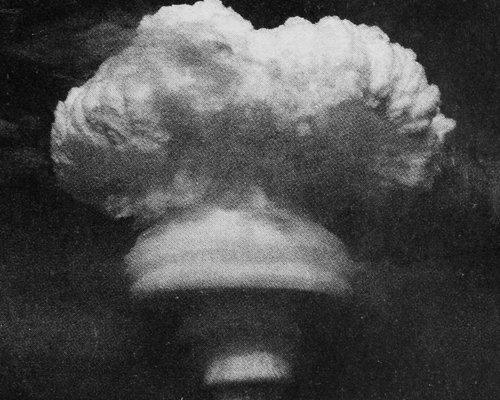HOME >> CHINA
Chinese netizens say H-bomb a backbone against US
Source:Global Times Published: 2019/6/17 22:03:40

China conducts its first hydrogen bomb test on June 17, 1967. Photo: IC
A blinding flash across the sky; a miniature sun of extreme heat explodes over the test site in western China. A deafening sound soon crackles through the air, as a huge mushroom cloud rises. This was the scene described by a flagship Chinese paper 52 years ago - on June 17, 1967 - when China conducted its first hydrogen bomb test.
Chinese Net users commemorated the 52nd anniversary of the landmark test on Monday, saying that the weapon has been the strongest backbone against foreign suppression over the past 50-plus years and there is nothing the Chinese people cannot accomplish, alluding to the Chinese's strong will to be self-reliant in strategic technologies and response to a trade war with the US.
Facing a severe international situation in the 1950s-60s, China was determined to develop "two bombs and one satellite" (atomic bomb, hydrogen bomb and artificial satellite) to defend against military threats by imperialists and nuclear blackmailing by major countries in order to safeguard peace. More than 17,000 researchers participated in the project, breaking technological blockade from Western countries.
Netizens hailed the significance of the weapon, saying that "this is what national security is really about and is the biggest pillar of the country's prosperity."
"This is our strongest possible backbone over the past 50 years against the US," a Sina Weibo user said. The US is again trying to undermine China's high-tech development, but with the "two bombs and one satellite" spirit, China can develop any technology, another Weibo user said.
After Huawei announced the use of backup chipsets in May, Chinese analysts said that Huawei's resilience can be seen as China's "Two Bombs, One Satellite" spirit in the new era, calling for greater self-reliance in the quest for core technological breakthroughs.
People's Daily, the flagship newspaper of the Communist Party of China, on Monday commemorated the anniversary, highlighting the nation's efforts to develop its nuclear industry to safeguard peace.
Since the reform and opening-up, China has independently built a complete nuclear industry, contributing to national defense and economic development, the report said.
In December 1991, China's first domestically developed and built nuclear power station Qinshan went online. In May 2015, Hualong One, China's independently developed third-generation reactor with full intellectual property, began construction in Fuqing, Fujian Province.
Posted in: DIPLOMACY